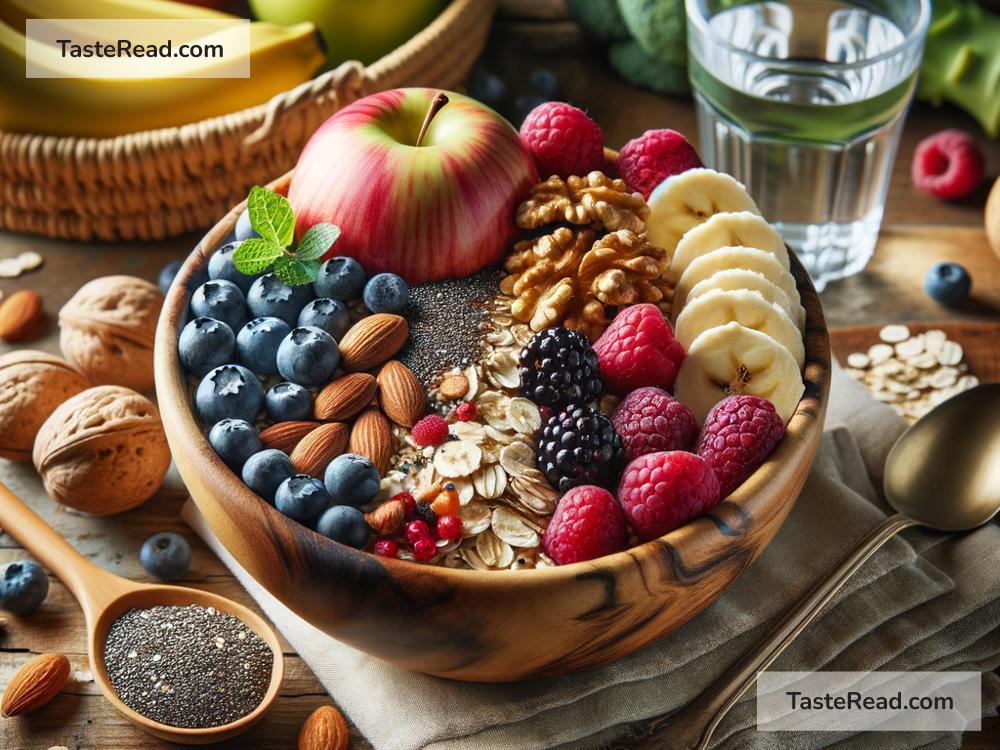Exploring the Role of Fiber in Digestive Health
When it comes to staying healthy, most people think about eating enough vitamins and staying active. But there’s another hero that often gets overlooked – fiber. Fiber is an essential part of a healthy diet, especially when it comes to keeping your digestive system running smoothly. In this blog, we’ll explore what fiber is, how it helps with digestion, and easy ways to add more of it to your diet.
What is Fiber?
Fiber is a type of carbohydrate found in plant-based foods like fruits, vegetables, grains, and legumes. Unlike other nutrients, fiber isn’t digested or absorbed by the body. Instead, it moves through your digestive system, helping it function effectively. There are two main types of fiber:
-
Soluble Fiber: This type dissolves in water and forms a gel-like substance in your stomach. It helps slow digestion and can lower cholesterol and blood sugar levels. Soluble fiber is found in foods like oats, apples, and beans.
-
Insoluble Fiber: This type doesn’t dissolve in water. Instead, it adds bulk to your stool, which helps food move through your digestive tract more easily. Insoluble fiber is found in foods like whole wheat bread, brown rice, and vegetables.
Both types of fiber play unique and important roles in digestion.
How Fiber Benefits Digestive Health
Fiber is like a gentle helper for your digestive system. Here’s how it keeps things running smoothly:
-
Prevents Constipation
Have you ever felt “stuck” after eating? That’s constipation. Fiber, especially insoluble fiber, helps prevent constipation by adding bulk to your stool and making it softer. This makes it easier to pass through your intestines. Think of fiber as your tummy’s natural broom, sweeping things along. -
Supports Gut Health
Your digestive system is home to trillions of tiny bacteria, known as gut microbiota. These friendly bacteria play an important role in breaking down food and keeping your gut healthy. Soluble fiber acts as food for these bacteria, helping them thrive. A healthy gut means better digestion and even stronger immunity. -
Helps Prevent Digestive Disorders
Eating enough fiber can lower your risk of developing digestive issues like irritable bowel syndrome (IBS), diverticulitis, and hemorrhoids. Fiber keeps your intestines healthy, which in turn helps prevent inflammation or damage to the digestive tract. -
Regulates Bowel Movements
Do you ever feel like your schedule is off because your gut is “off”? Fiber helps maintain regular bowel movements, which is essential for feeling healthy and energized. -
Manages Weight by Promoting Fullness
Although this isn’t strictly a digestive benefit, fiber can help you feel fuller for longer. This can prevent overeating and support weight management – both of which affect digestive health.
How Much Fiber Do You Need?
Most people don’t eat enough fiber. The recommended daily intake is about 25 grams for women and 38 grams for men, but the average person eats far less than this. Getting the right amount of fiber is key to good health, both for your gut and the rest of your body.
Simple Ways to Eat More Fiber
Adding fiber to your diet doesn’t have to be complicated! Here are some easy tips to boost your fiber intake:
-
Start Your Day with Whole Grains
Choose whole-grain cereals, oatmeal, or whole-grain bread for breakfast instead of refined grains like white bread or sugary cereals. -
Snack on Fruits and Veggies
Fresh fruits like apples, pears, and berries are great sources of fiber. Veggies like carrots, celery, and broccoli make crunchy, fiber-rich snacks. -
Add Beans and Lentils to Meals
Beans, lentils, and chickpeas are packed with fiber. Add them to soups, salads, or casseroles for an easy boost. -
Go Nuts for Nuts
Nuts and seeds like almonds, chia seeds, and sunflower seeds are high in fiber. They’re perfect as a snack or sprinkled on yogurt or salads. -
Swap White Rice and Pasta for Whole Grains
Choose brown rice, quinoa, or whole-grain pasta instead of refined versions to up your fiber intake without sacrificing taste. -
Eat the Peel
When eating fruits and vegetables like apples, pears, and potatoes, keep the skin on whenever possible. The peel often contains extra fiber. -
Try Fiber Supplements
If you’re having trouble getting enough fiber from food, you could consider fiber supplements like psyllium husk. However, it’s always best to get fiber from natural sources first.
A Quick Word of Caution
While adding fiber to your diet is great for your health, it’s important to increase your intake slowly. Eating too much fiber too quickly can cause bloating, gas, or stomach cramps. Drink plenty of water as you add more fiber to your diet. Fiber works best when your body stays hydrated.
The Bottom Line
Fiber might not seem exciting, but it plays a key role in keeping your digestive system healthy and happy. It helps prevent constipation, supports a healthy gut, and even contributes to your overall weight and well-being. By making small changes to your diet – like eating more fruits, veggies, and whole grains – you can easily boost your fiber intake. Remember, taking care of your digestive health can help you feel better in both body and mind.
So, the next time you plan your meals, ask yourself: Is there enough fiber here? Your gut will thank you!


